An Integrated Comparative Assessment of Coal-Based Carbon Capture and Storage (CCS) Vis-à-Vis Renewable Energies in India’s Low Carbon Electricity Transition Scenarios
Abstract
1. Introduction
2. Materials and Methods
2.1. Coal-CCS Pathways 2050
2.2. Costs
2.3. Climate Footprint
2.4. Water Footprint
3. Indicator-Wise Assessments and Results
3.1. Coal-CCS Pathways 2050
3.1.1. Energy Scenario Analysis
3.1.2. CO2 Storage Potential and Demand
3.1.3. Commercial Availability
3.2. Costs
3.2.1. LCOE for Coal-Based Power Plants
3.2.2. LCOE for Renewable Power Plants
3.2.3. LCOE Results and Analysis
3.2.4. Sensitivity Analyses
(a) Impact of Carbon Costs on LCOE
(b) Impact of Coal Fuel Cost Escalation Rates
(c) LCOE Sensitivity to Coal-CCS Capex
(d) Impact of CUF on Coal Power Plants
3.3. Climate Footprint
3.4. Water Footprint
4. Integrated Comparative Assessment: Results and Discussion
4.1. Energy-Cost-Climate-Water Nexus
4.2. Economic “Operating Space” for Additional Energy Storage by 2030
4.3. Benchmarking with Other Studies
4.4. Limitations and Further Research
5. Conclusions
Supplementary Materials
Author Contributions
Funding
Institutional Review Board Statement
Informed Consent Statement
Data Availability Statement
Acknowledgments
Conflicts of Interest
Abbreviations
| Coal / conventional coal | conventional supercritical coal power plants (without CCS) |
| Coal-CCS | CCS-equipped supercritical coal power plants |
| Solar PV | utility-scale solar photovoltaic power plants |
| Wind | large onshore wind power plants |
| GHGs | greenhouse gases |
| LCOE | levelized cost of electricity generation |
| aLCOE | advanced levelized cost of electricity generation |
| PPAs | power purchase agreements |
| Capex | capital expenditure |
| Opex | operation and maintenance expenditure (annual) |
| CUF | capacity utilisation factor |
References
- IEA. World Energy Outlook; International Energy Agency: Paris, France, 2019. [Google Scholar]
- IEA. WEO-2015 Special Report: India Energy Outlook; International Energy Agency: Paris, France, 2015. [Google Scholar]
- CEA. Annual Report 2018–2019; Central Electricity Authority, Ministry of Power, Government of India: New Delhi, India, 2019. [Google Scholar]
- World Resources Institute, W.R.I. ClimateWatch: Global Historical Emissions. 2016. Available online: https://www.climatewatchdata.org/ghg-emissions (accessed on 3 June 2020).
- World Resources Institute, W.R.I. 4 Charts Explain Greenhouse Gas Emissions by Countries and Sectors. 2020. Available online: https://www.wri.org/blog/2020/02/greenhouse-gas-emissions-by-country-sector (accessed on 3 June 2020).
- Jiang, J.; Ye, B.; Liu, J. Research on the peak of CO2 emissions in the developing world: Current progress and future prospect. Appl. Energy 2019, 235, 186–203. [Google Scholar] [CrossRef]
- MOEFCC. India’s Second Biennial Update Report to the United Nations Framework Convention on Climate Change; Ministry of Environment, Forest and Climate Change, Government of India: New Delhi, India, 2018. [Google Scholar]
- ClimateActionTracker. Country Summary: India. 2020. Available online: https://climateactiontracker.org/countries/india/ (accessed on 3 June 2020).
- Mittal, S.; Dai, H.; Fujimori, S.; Masui, T. Bridging greenhouse gas emissions and renewable energy deployment target: Comparative assessment of China and India. Appl. Energy 2016, 166, 301–313. [Google Scholar] [CrossRef]
- Mallapragada, D.S.; Naik, I.; Ganesan, K.; Banerjee, R.; Laurenzi, I.J. Life Cycle Greenhouse Gas Impacts of Coal and Imported Gas-Based Power Generation in the Indian Context. Environ. Sci. Technol. 2018, 53, 539–549. [Google Scholar] [CrossRef]
- Shukla, P.; Dhar, S.; Pathak, M.; Mahadevia, D.; Garg, A. Pathways to Deep Decarbonization in India; SDSN-IDDRI: Copenhagen, Denmark, 2015. [Google Scholar]
- Selosse, S.; Ricci, O. Carbon capture and storage: Lessons from a storage potential and localization analysis. Appl. Energy 2017, 188, 32–44. [Google Scholar] [CrossRef]
- Pfeiffer, A.; Millar, R.; Hepburn, C.; Beinhocker, E. The ‘2 °C capital stock’ for electricity generation: Committed cumulative carbon emissions from the electricity generation sector and the transition to a green economy. Appl. Energy 2016, 179, 1395–1408. [Google Scholar] [CrossRef]
- Mittal, S.; Liu, J.-Y.; Fujimori, S.; Shukla, P.R. An assessment of near-to-mid-term economic impacts and energy transitions under “2 °C” and “1.5 °C” scenarios for India. Energies 2018, 11, 2213. [Google Scholar] [CrossRef]
- Vishwanathan, S.S.; Garg, A.; Tiwari, V.; Shukla, P.R. India in 2 C and well below 2 C worlds: Opportunities and challenges. Carbon Manag. 2018, 9, 459–479. [Google Scholar] [CrossRef]
- Garg, A.; Shukla, P.R. Coal and energy security for India: Role of carbon dioxide (CO2) capture and storage (CCS). Energy 2009, 34, 1032–1041. [Google Scholar] [CrossRef]
- Garg, A.; Shukla, P.R.; Parihar, S.; Singh, U.; Kankal, B. Cost-effective architecture of carbon capture and storage (CCS) grid in India. Int. J. Greenh. Gas. Control. 2017, 66, 129–146. [Google Scholar] [CrossRef]
- Garg, A.; Tiwari, V.; Vishwanathan, S. Relevance of clean coal technology for India’s energy security: A policy perspective. In Proceedings of the IOP Conference Series: Earth and Environmental Science, New Delhi, India, 13–14 February 2017; Volume 76, p. 12001. [Google Scholar]
- Kumar Shukla, A.; Ahmad, Z.; Sharma, M.; Dwivedi, G.; Nath Verma, T.; Jain, S.; Verma, P.; Zare, A. Advances of carbon capture and storage in coal-based power generating units in an Indian context. Energies 2020, 13, 4124. [Google Scholar] [CrossRef]
- Sifat, N.S.; Haseli, Y. A critical review of CO2 capture technologies and prospects for clean power generation. Energies 2019, 12, 4143. [Google Scholar] [CrossRef]
- Shearer, C.; Fofrich, R.; Davis, S.J. Future CO2 emissions and electricity generation from proposed coal-fired power plants in India. Earth’s Futur. 2017, 5, 408–416. [Google Scholar] [CrossRef]
- Kumar, R.; Jilte, R.; Nikam, K.C.; Ahmadi, M.H. Status of carbon capture and storage in India’s coal fired power plants: A critical review. Environ. Technol. Innov. 2019, 13, 94–103. [Google Scholar] [CrossRef]
- Sharma, N. Silver bullet or bitter pill? Reassessing the scope of CO2 capture and storage in India. Carbon Manag. 2018, 9, 311–332. [Google Scholar] [CrossRef]
- Viebahn, P.; Vallentin, D.; Höller, S. Prospects of carbon capture and storage (CCS) in India’s power sector-An integrated assessment. Appl. Energy 2014, 117, 62–75. [Google Scholar] [CrossRef]
- Singh, U.; Rao, A.B.; Chandel, M.K. Economic implications of CO2 capture from the existing as well as proposed coal-fired power plants in india under various policy scenarios. Energy Procedia 2017, 114, 7638–7650. [Google Scholar] [CrossRef]
- Sharma, N.; Mahapatra, S.S. A preliminary analysis of increase in water use with carbon capture and storage for Indian coal-fired power plants. Environ. Technol. Innov. 2018, 9, 51–62. [Google Scholar] [CrossRef]
- Kumar, H.; Upadhyay, M.K.; Bansal, R.; Gupta, R. Energizing India: A Joint Project Report of NITI Aayog and IEEJ. 2017. Available online: https://niti.gov.in/writereaddata/files/Energising-India.pdf (accessed on 30 December 2020).
- IESS. India Energy Security Scenarios: User Guide for Carbon Capture Storage (CCS). 2015. Available online: http://iess2047.gov.in/pathways/22202222222222220222222222012222202222222211202220222022222/primary_energy_chart (accessed on 30 December 2020).
- Greenpeace. Energy [r]evolution: A Sustainable world Energy Outlook; Greenpeace International: Stuttgart, Germany, 2015; Available online: https://elib.dlr.de/98314/1/Energy-Revolution-2015-Full.pdf (accessed on 30 December 2020).
- Greenpeace. Energy [r]evolution: A Sustainable India Energy Outlook; Greenpeace International: Stuttgart, Germany, 2012; Available online: http://www.indiaenvironmentportal.org.in/content/366606/energy-revolution-a-sustainable-energy-outlook-for-india-2012/ (accessed on 30 December 2020).
- Gulagi, A.; Bogdanov, D.; Breyer, C. The role of storage technologies in energy transition pathways towards achieving a fully sustainable energy system for India. J. Energy Storage 2017, 17, 525–539. [Google Scholar] [CrossRef]
- Anandarajah, G.; Gambhir, A. India’s CO2 emission pathways to 2050: What role can renewables play? Appl. Energy 2014, 131, 79–86. [Google Scholar] [CrossRef]
- Audoly, R.; Vogt-Schilb, A.; Guivarch, C.; Pfeiffer, A. Pathways toward zero-carbon electricity required for climate stabilization. Appl. Energy 2018, 225, 884–901. [Google Scholar] [CrossRef]
- Ram, M.; Child, M.; Aghahosseini, A.; Bogdanov, D.; Lohrmann, A.; Breyer, C. A comparative analysis of electricity generation costs from renewable, fossil fuel and nuclear sources in G20 countries for the period 2015–2030. J. Clean. Prod. 2018, 199, 687–704. [Google Scholar]
- Srinivasan, S.; Kholod, N.; Chaturvedi, V.; Ghosh, P.P.; Mathur, R.; Clarke, L.; Evans, M.; Hejazi, M.; Kanudia, A.; Koti, P.N.; et al. Water for electricity in India: A multi-model study of future challenges and linkages to climate change mitigation. Appl. Energy 2018, 210, 673–684. [Google Scholar] [CrossRef]
- Mishra, N.; Das, N. Coal Mining and Local Environment: A Study in Talcher Coalfield of India. Air Soil Water Res. 2017, 10. [Google Scholar] [CrossRef]
- Guttikunda, S.K.; Jawahar, P. Atmospheric emissions and pollution from the coal-fired thermal power plants in India. Atmos. Environ. 2014, 92, 449–460. [Google Scholar] [CrossRef]
- Krishna Priya, G.S.; Bandyopadhyay, S. Multi-objective pinch analysis for power system planning. Appl. Energy 2017, 202, 335–347. [Google Scholar] [CrossRef]
- Holland, R.A.; Scott, K.; Agnolucci, P.; Rapti, C.; Eigenbrod, F.; Taylor, G. The influence of the global electric power system on terrestrial biodiversity. Proc. Natl. Acad. Sci. USA 2019, 116, 26078–26084. [Google Scholar] [CrossRef]
- Mitavachan, H.; Srinivasan, J. Multi-criteria sustainability assessment of coal and solar power generation in India. Curr. Sci. 2017, 113, 1034–1038. [Google Scholar]
- Murrant, D.; Radcliffe, J. Assessing energy storage technology options using a multi-criteria decision analysis-based framework. Appl. Energy 2018, 231, 788–802. [Google Scholar] [CrossRef]
- Li, T.; Roskilly, A.P.; Wang, Y. Life cycle sustainability assessment of grid-connected photovoltaic power generation: A case study of Northeast England. Appl. Energy 2018, 227, 465–479. [Google Scholar] [CrossRef]
- Moslehi, S.; Reddy, T.A. A new quantitative life cycle sustainability assessment framework: Application to integrated energy systems. Appl. Energy 2019, 239, 482–493. [Google Scholar] [CrossRef]
- Hiremath, M.; Derendorf, K.; Vogt, T. Comparative life cycle assessment of battery storage systems for stationary applications. Environ. Sci. Technol. 2015, 49. [Google Scholar] [CrossRef] [PubMed]
- Sharifzadeh, M.; Hien, R.K.T.; Shah, N. China’s roadmap to low-carbon electricity and water: Disentangling greenhouse gas (GHG) emissions from electricity-water nexus via renewable wind and solar power generation, and carbon capture and storage. Appl. Energy 2019, 235, 31–42. [Google Scholar] [CrossRef]
- Lee, J.-Y.; Lin, H.-F. Multi-Footprint Constrained Energy Sector Planning. Energies 2019, 12, 2329. [Google Scholar] [CrossRef]
- Sanchez Moore, C.C.; Kulay, L. Effect of the implementation of carbon capture systems on the environmental, energy and economic performance of the Brazilian electricity matrix. Energies 2019, 12, 331. [Google Scholar] [CrossRef]
- Viebahn, P.; Daniel, V.; Samuel, H. Integrated assessment of carbon capture and storage (CCS) in the German power sector and comparison with the deployment of renewable energies. Appl. Energy 2012, 97, 238–248. [Google Scholar] [CrossRef]
- Viebahn, P.; Vallentin, D.; Höller, S. Prospects of carbon capture and storage (CCS) in China’s power sector—An integrated assessment. Appl. Energy 2015, 157, 229–244. [Google Scholar] [CrossRef]
- Viebahn, P.; Vallentin, D.; Höller, S. Integrated assessment of carbon capture and storage (CCS) in South Africa’s power sector. Energies 2015, 8, 14380–14406. [Google Scholar] [CrossRef]
- Gleick, P.H. Water and Energy. Annu. Rev. Energy Environ. 1994, 19, 267–299. [Google Scholar] [CrossRef]
- Zhang, Y.; Fang, J.; Wang, S.; Yao, H. Energy-water nexus in electricity trade network: A case study of interprovincial electricity trade in China. Appl. Energy 2020, 257, 113685. [Google Scholar] [CrossRef]
- World Economic Forum Water Initiative. Water Security: The Water-Food-Energy-Climate Nexus; Island Pres: Washington, DC, USA, 2012. [Google Scholar]
- Cui, Q.; He, L.; Han, G.; Chen, H.; Cao, J. Review on climate and water resource implications of reducing renewable power curtailment in China: A nexus perspective. Appl. Energy 2020, 267, 115114. [Google Scholar] [CrossRef]
- Chen, C.; Yu, L.; Zeng, X.; Huang, G.; Li, Y. Planning an Energy--Water--Environment Nexus System in Coal-Dependent Regions under Uncertainties. Energies 2020, 13, 208. [Google Scholar] [CrossRef]
- Amjath-Babu, T.S.; Sharma, B.; Brouwer, R.; Rasul, G.; Wahid, S.M.; Neupane, N.; Bhattarai, U.; Sieber, S. Integrated modelling of the impacts of hydropower projects on the water-food-energy nexus in a transboundary Himalayan river basin. Appl. Energy 2019, 239, 494–503. [Google Scholar] [CrossRef]
- Chang, Y.; Li, G.; Yao, Y.; Zhang, L.; Yu, C. Quantifying the water-energy-food nexus: Current status and trends. Energies 2016, 9, 65. [Google Scholar] [CrossRef]
- Price, J.; Zeyringer, M.; Konadu, D.; Sobral Mourão, Z.; Moore, A.; Sharp, E. Low carbon electricity systems for Great Britain in 2050: An energy-land-water perspective. Appl. Energy 2018, 228, 928–941. [Google Scholar] [CrossRef]
- Venghaus, S.; Märker, C.; Dieken, S.; Siekmann, F. Linking Environmental Policy Integration and the Water-Energy-Land-(Food-) Nexus: A Review of the European Union’s Energy, Water, and Agricultural Policies. Energies 2019, 12, 4446. [Google Scholar] [CrossRef]
- Yan, J.; Zhang, Z. Carbon Capture, Utilization and Storage (CCUS). Appl. Energy 2019, 235, 1289–1299. [Google Scholar] [CrossRef]
- Fan, J.-L.; Xu, M.; Li, F.; Yang, L.; Zhang, X. Carbon capture and storage (CCS) retrofit potential of coal-fired power plants in China: The technology lock-in and cost optimization perspective. Appl. Energy 2018, 229, 326–334. [Google Scholar] [CrossRef]
- Hammond, G.P.; Spargo, J. The prospects for coal-fired power plants with carbon capture and storage: A UK perspective. Energy Convers. Manag. 2014, 86, 476–489. [Google Scholar] [CrossRef]
- Wang, Y.; Nian, V.; Li, H.; Yuan, J. Life cycle analysis of integrated gasification combined cycle power generation in the context of Southeast Asia. Energies 2018, 11, 1587. [Google Scholar] [CrossRef]
- Viebahn, P.; Nitsch, J.; Fischedick, M.; Esken, A.; Schüwer, D.; Supersberger, N.; Zuberbühler, U.; Edenhofer, O. Comparison of carbon capture and storage with renewable energy technologies regarding structural, economic, and ecological aspects in Germany. Int. J. Greenh. Gas. Control. 2007, 1, 121–133. [Google Scholar] [CrossRef]
- Meldrum, J.; Nettles-Anderson, S.; Heath, G.; Macknick, J. Life cycle water use for electricity generation: A review and harmonization of literature estimates. Environ. Res. Lett. 2013, 8, 15031. [Google Scholar] [CrossRef]
- Jin, Y.; Behrens, P.; Tukker, A.; Scherer, L. Water use of electricity technologies: A global meta-analysis. Renew. Sustain. Energy Rev. 2019, 115, 109391. [Google Scholar] [CrossRef]
- Schmidt, T.S.; Beuse, M.; Zhang, X.; Steffen, B.; Schneider, S.F.; Pena-Bello, A.; Bauer, C.; Parra, D. Additional emissions and cost from storing electricity in stationary battery systems. Environ. Sci. Technol. 2019, 53, 3379–3390. [Google Scholar] [CrossRef]
- Rohatgi, A. WebPlotDigitizer, Version: 4.3. Available online: https://automeris.io/WebPlotDigitizer (accessed on 25 July 2020).
- Ricke, K.; Drouet, L.; Caldeira, K.; Tavoni, M. Country-level social cost of carbon. Nat. Clim. Chang. 2018, 8, 895–900. [Google Scholar] [CrossRef]
- IEA. Technology Roadmap: Carbon Capture and Storage; International Energy Agency: Paris, France, 2013. [Google Scholar]
- Udetanshu, B.P.; Khurana, S.; Nelson, D. Developing a Roadmap to a Flexible, Low-Carbon Indian Electricity System: Interim Findings; Climate Policy Initiative: New Delhi, India, 2019; Available online: https://www.climatepolicyinitiative.org/publication/developing-a-roadmap-to-a-flexible-low-carbon-indian-electricity-system-interim-findings/ (accessed on 30 December 2020).
- Tiewsoh, L.S.; Jirásek, J.; Sivek, M. Electricity generation in India: Present state, future outlook and policy implications. Energies 2019, 12, 1361. [Google Scholar] [CrossRef]
- Lawrenz, L.; Xiong, B.; Lorenz, L.; Krumm, A.; Hosenfeld, H.; Burandt, T.; Löffler, K.; Oei, P.-Y.; Von Hirschhausen, C. Exploring energy pathways for the low-carbon transformation in India—A model-based analysis. Energies 2018, 11, 3001. [Google Scholar] [CrossRef]
- TERI. Transitions in Indian Electricity Sector 2017–2030; The Energy and Resources Institute: New Delhi, India, 2017; Available online: https://www.teriin.org/files/transition-report/files/downloads/Transitions-in-Indian-Electricity-Sector_Report.pdf (accessed on 30 December 2020).
- Pachouri, R.; Spencer, T.; Renjith, G. Exploring Electricity Supply-Mix Scenarios to 2030; The Energy and Resources Institute: New Delhi, India, 2019; Available online: https://www.teriin.org/sites/default/files/2019-02/Exploring%20Electricity%20Supply-Mix%20Scenarios%20to%202030.pdf (accessed on 30 December 2020).
- CSTEP. Quality of Life for All: A Sustainable Development Framework for India’s Climate Policy; Center for Study of Science, Technology and Policy: Bengaluru, India, 2015; Available online: http://www.cstep.in/drupal/sites/default/files/2019-01/CSTEP_RR_Quality_of_Life_for_All_2015_technical_report.pdf (accessed on 30 December 2020).
- Ahluwalia, M.S.; Gupta, H.; Stern, N.H. A More Sustainable Energy Strategy for India; ICRIER: New Delhi, India, 2016; Available online: https://icrier.org/pdf/Working_Paper_328.pdf (accessed on 30 December 2020).
- Viebahn, P.; Höller, S.; Vallentin, D.; Liptow, H.; Villar, A. Future CCS implementation in India: A systemic and long-term analysis. Energy Procedia 2011, 4, 2708–2715. [Google Scholar] [CrossRef][Green Version]
- Dooley, J.J.; Kim, S.H.; Edmonds, J.A.; Friedman, S.J.; Wise, M.A. A first-order global geological CO2-storage potential supply curve and its application in a global integrated assessment model. In Greenhouse Gas Control Technologies 7; Elsevier: Amsterdam, The Netherlands, 2005; pp. 573–581, Friedman, S.J. [Google Scholar]
- Singh, A.K.; Mendhe, V.A.; Garg, A. CO2 Storage Potential of Geologic Formations in India. In Proceedings of the 8th Greenhouse Gas Technology Conference, Trondheim, Norway, 19–22 June 2006. [Google Scholar]
- Holloway, S.; Garg, A.; Kapshe, M.; Deshpande, A.; Pracha, A.S.; Khan, S.R.; Mahmood, M.A.; Singh, T.N.; Kirk, K.L.; Gale, J. An assessment of the CO2 storage potential of the Indian subcontinent. Energy Procedia 2009, 1, 2607–2613. [Google Scholar] [CrossRef]
- GCCSI. The Global Status of CCS 2019; Global CCS Institute: Melbourne, Australia, 2019; Available online: https://www.globalccsinstitute.com/wp-content/uploads/2019/12/GCC_GLOBAL_STATUS_REPORT_2019.pdf (accessed on 30 December 2020).
- CEA. National Electricity Plan. (Volume I): Generation; Central Electricity Authority, Ministry of Power, Government of India: New Delhi, India, 2018. [Google Scholar]
- IEA. World Energy Outlook; International Energy Agency: Paris, France, 2018. [Google Scholar]
- CERC. Consultation Paper on Terms And Conditions of Tariff Regulations for Tariff Period. 1.4.2019 to 31.3.2024; Central Electricity Regulatory Commission, Government of India: New Delhi, India, 2018. Available online: http://cercind.gov.in/2018/draft_reg/AP.pdf (accessed on 30 December 2020).
- CSTEP. Benefit Cost Analysis of Emission Standards for Coal-based Thermal Power Plants in India; Center for Study of Science, Technology and Policy: Bengaluru, India, 2018; Available online: https://shaktifoundation.in/wp-content/uploads/2018/07/Benefit-cost-analysis-of-emission-standards-for-coal-based-thermal-power-plants-in-India-1.pdf (accessed on 30 December 2020).
- Vinca, A.; Rottoli, M.; Marangoni, G.; Tavoni, M. The role of carbon capture and storage electricity in attaining 1.5 and 2 °C. Int. J. Greenh. Gas. Control. 2018, 78, 148–159. [Google Scholar] [CrossRef]
- IEA. World Energy Outlook; International Energy Agency: Paris, France, 2016; Available online: https://www.oecd-ilibrary.org/energy/world-energy-outlook-2016_weo-2016-en (accessed on 30 December 2020).
- LAZARD. Lazard’s Levelized Cost of Energy Analysis—Version 13.0. 2019. Available online: https://www.lazard.com/media/451086/lazards-levelized-cost-of-energy-version-130-vf.pdf (accessed on 30 December 2020).
- Samadi, S. The social costs of electricity generation—Categorising different types of costs and evaluating their respective relevance. Energies 2017, 10, 356. [Google Scholar] [CrossRef]
- CPI. An Assessment of India’s Energy Choices: Managing India’s Renewable Energy Integration through Flexibility; Climate Policy Initiative: New Delhi, India, 2018; Available online: https://climatepolicyinitiative.org/wp-content/uploads/2018/05/Managing-Indias-Renewable-Energy-Integration-through-Flexibility-.pdf (accessed on 30 December 2020).
- Spencer, T.; Pachouri, R.; Renjith, G.; Vohra, S. Coal transition in India; The Energy and Resources Institute (TERI): New Delhi, India, 2018; Available online: https://www.climate-transparency.org/wp-content/uploads/2019/01/Coal-Transition-in-India.pdf (accessed on 30 December 2020).
- Mohan, R.R.; Dharmala, N.; Ananthakumar, M.R.; Kumar, P.; Bose, A. Greenhouse Gas. Emission Estimates from the Energy Sector in India at the Sub- National Level (Version/edition 2.0); GHG Platform India Report—CSTEP: New Delhi, India, 2019; Available online: http://www.ghgplatform-india.org/methodology-electricityenergy-sector (accessed on 30 December 2020).
- IEA. Cleaner Coal in China; International Energy Agency: Paris, France, 2009. [Google Scholar]
- Eggleston, S.; Buendia, L.; Miwa, K.; Ngara, T.; Tanabe, K. 2006 IPCC Guidelines for National Greenhouse Gas Inventories: Stationary Combustion; Institute for Global Environmental Strategies: Hayama, Japan, 2006; Volume 5. [Google Scholar]
- Samadi, S. The experience curve theory and its application in the field of electricity generation technologies-A literature review. Renew. Sustain. Energy Rev. 2018, 82, 2346–2364. [Google Scholar] [CrossRef]
- TNERC. Order on Generic Tariff for Wind Power and Related Issues; Tamil Nadu Electricity Regulatory Commission: Chennai, India, 2018; Available online: http://www.tnerc.gov.in/orders/TariffOrder2009/2018/Wind-6of2018.pdf (accessed on 30 December 2020).
- TNERC. Order on Generic Tariff for Solar Power and Related Issues; Tamil Nadu Electricity Regulatory Commission: Chennai, India, 2019. Available online: http://www.tnerc.gov.in/orders/Tariff%20Order%202009/2019/Solar-5-29-03-2019.pdf (accessed on 30 December 2020).
- KERC. Determination of Tariff in Respect of Solar Power Projects (Including Solar Rooftop Photovoltaic Projects) for FY20; Karnataka Electricity Regulatory Commission: Bengaluru, India, 2019; Available online: https://kredlinfo.in/Tariff/Determination of tariff in respect of SOlar Power Projects (including Solar Rooftop Photovoltaic Projects for FY20).pdf (accessed on 30 December 2020).
- KERC. Generic Tariff for Wind Power Projects 2019; Karnataka Electricity Regulatory Commission: Bengaluru, India, 2019; Available online: https://karunadu.karnataka.gov.in/kerc/Miscellaneous Orders 2018/Generic Tariff Order/Generic-Tariff-Order-for-WindPowerProject-2019.pdf (accessed on 30 December 2020).
- Chaurasiya, P.K.; Warudkar, V.; Ahmed, S. Wind energy development and policy in India: A review. Energy Strateg. Rev. 2019, 24, 342–357. [Google Scholar] [CrossRef]
- Naqvi, A.I.; Saxena, P. Unravelling India’s 2.44 rupee solar tariff: Refined sensibility or a churlish audacity?; PVTECH. July 2018. Available online: https://www.pv-tech.org/guest-blog/unravelling-indias-2.44-rupee-solar-tariff-refined-sensibility-or-a-churlis (accessed on 30 December 2020).
- CERC. Terms and Conditions for Tariff determination from Renewable Energy Sources; Central Electricity Regulatory Commission, Government of India: New Delhi, India, 2016. Available online: http://cercind.gov.in/2016/orders/sm_3.pdf (accessed on 30 December 2020).
- Cuéllar-Franca, R.M.; Azapagic, A. Carbon capture, storage and utilisation technologies: A critical analysis and comparison of their life cycle environmental impacts. J. CO2 Util. 2015, 9, 82–102. [Google Scholar] [CrossRef]
- Petrescu, L.; Bonalumi, D.; Valenti, G.; Cormos, A.-M.; Cormos, C.-C. Life Cycle Assessment for supercritical pulverized coal power plants with post-combustion carbon capture and storage. J. Clean. Prod. 2017, 157, 10–21. [Google Scholar] [CrossRef]
- Pehnt, M.; Henkel, J. Life cycle assessment of carbon dioxide capture and storage from lignite power plants. Int. J. Greenh. Gas. Control. 2009, 3, 49–66. [Google Scholar] [CrossRef]
- Odeh, N.A.; Cockerill, T.T. Life cycle GHG assessment of fossil fuel power plants with carbon capture and storage. Energy Policy 2008, 36, 367–380. [Google Scholar] [CrossRef]
- Korre, A.; Nie, Z.; Durucan, S. Life cycle modelling of fossil fuel power generation with post-combustion CO2 capture. Int. J. Greenh. Gas. Control. 2010, 4, 289–300. [Google Scholar] [CrossRef]
- Koornneef, J.; van Keulen, T.; Faaij, A.; Turkenburg, W. Life cycle assessment of a pulverized coal power plant with post-combustion capture, transport and storage of CO2. Int. J. Greenh. Gas Control. 2008, 2, 448–467. [Google Scholar] [CrossRef]
- Singh, B.; Strømman, A.H.; Hertwich, E.G. Comparative life cycle environmental assessment of CCS technologies. Int. J. Greenh. Gas. Control. 2011, 5, 911–921. [Google Scholar] [CrossRef]
- Viebahn, P. Life Cycle Assessment for Power Plants with CCS. In Efficient Carbon Capture for Coal Power Plants; Stolten, D., Scherer, V., Eds.; WILEY-VCH: Weinheim, Germany, 2011; pp. 83–109. ISBN 978-3-527-33002-7. [Google Scholar]
- Leccisi, E.; Raugei, M.; Fthenakis, V. The energy and environmental performance of ground-mounted photovoltaic systems—A timely update. Energies 2016, 9, 622. [Google Scholar] [CrossRef]
- Kadiyala, A.; Kommalapati, R.; Huque, Z. Characterization of the life cycle greenhouse gas emissions from wind electricity generation systems. Int. J. Energy Environ. Eng. 2017, 8, 55–64. [Google Scholar] [CrossRef]
- WRI. 3 Maps Explain India’s Growing Water Risks; World Resources Institute: Washington, DC, USA, 2015; Available online: https://www.wri.org/blog/2015/02/3-maps-explain-india-s-growing-water-risks (accessed on 3 June 2020).
- WRI. Over Heating: Financial Risks from Water Constraints on Power Generation in Asia; World Resources Institute: Washington, DC, USA, 2010; Available online: http://pdf.wri.org/over_heating_asia.pdf (accessed on 30 December 2020).
- Scott, C.A.; Sugg, Z.P. Global energy development and climate-induced water scarcity—Physical limits, sectoral constraints, and policy imperatives. Energies 2015, 8, 8211–8225. [Google Scholar] [CrossRef]
- CCO. Provisional Coal Statistics 2016–2017; Coal Controller’s Organisation, Ministry of Coal, Government of India: Kolkata, India, 2017. Available online: http://www.coalcontroller.gov.in/writereaddata/files/download/provisionalcoalstat/ProvisionalCoalStat2016-17.pdf (accessed on 30 December 2020).
- Chaturvedi, V.; Nagar-Koti, P.; Sugam, R.; Neog, K.; Hejazi, M. Implications of Shared Socio-Economic Pathways for India’s Long-Term Electricity Generation and Associated Water Demands; Council on Energy, Environment and Water: New Delhi, India, 2017; Available online: https://www.ceew.in/sites/default/files/CEEW-Implications-of-Shared-Socio-Economic-Pathways-for-India-Longterm_0.pdf (accessed on 30 December 2020).
- IRENA. Water Use in India’s Power Generation: Impact of Renewables and Improved Cooling Technologies to 2030; International Renewable Energy Agency: Masdar, Abu Dhabi, 2018; Available online: https://www.irena.org/-/media/Files/IRENA/Agency/Publication/2018/Jan/IRENAIndiapowerwater2018pdf.pdf (accessed on 30 December 2020).
- Ou, Y.; Zhai, H.; Rubin, E.S. Life cycle water use of coal-and natural-gas-fired power plants with and without carbon capture and storage. Int. J. Greenh. Gas. Control. 2016, 44, 249–261. [Google Scholar] [CrossRef]
- Zhai, H.; Rubin, E.S.; Versteeg, P.L. Water use at pulverized coal power plants with postcombustion carbon capture and storage. Environ. Sci. Technol. 2011, 45, 2479–2485. [Google Scholar] [CrossRef] [PubMed]
- Central Electricity Authority CEA. Growth of Electricity Sector in India from 1947–2019; Central Electricity Authority: New Delhi, India, 2019. [Google Scholar]
- Ramanathan, S.; Arora, S.; Trivedi, V. Coal-Based Power Norms: Where Do We Stand Today? Centre for Science and Environment (CSE): New Delhi, India, 2020. Available online: https://www.cseindia.org/coal-based-power-norms-coal-based-10125 (accessed on 30 December 2020).
- Rodell, M.; Velicogna, I.; Famiglietti, J.S. Satellite-based estimates of groundwater depletion in India. Nature 2009. [Google Scholar] [CrossRef] [PubMed]
- CWC. Water and Related Statistics; Central Water Commission, Ministry of Jal Shakti, Government of India: New Delhi, India, 2019; Available online: http://www.indiaenvironmentportal.org.in/files/file/water-and-related-statistics-2019.pdf (accessed on 30 December 2020).
- Barros, V.R.; Field, C.B.; Dokken, D.J.; Mastrandrea, M.D.; Mach, K.J.; Bilir, T.E.; Chatterjee, M.; Ebi, K.L.; Estrada, Y.O.; Genova, R.C.; et al. Climate Change 2014 Impacts, Adaptation, and Vulnerability Part. B: Regional Aspects: Working Group ii Contribution to the Fifth Assessment Report of the Intergovernmental Panel on Climate Change; Cambridge University Press: Cambridge, UK, 2014; ISBN 9781107415386. [Google Scholar]
- Yang, L.; Lv, H.; Jiang, D.; Fan, J.; Zhang, X.; He, W.; Zhou, J.; Wu, W. Whether CCS technologies will exacerbate the water crisis in China?—A full life-cycle analysis. Renew. Sustain. Energy Rev. 2020, 134, 110374. [Google Scholar] [CrossRef]
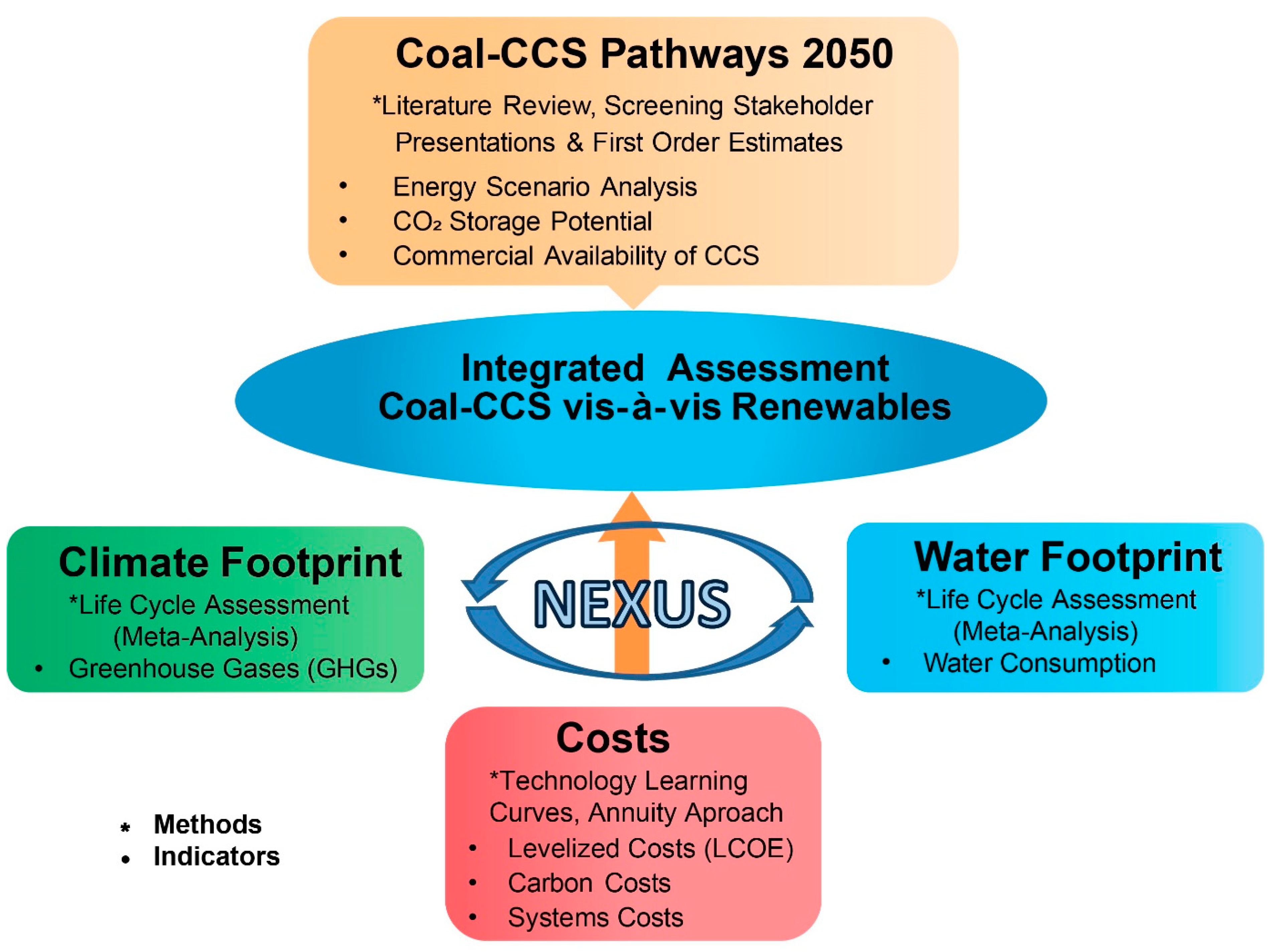
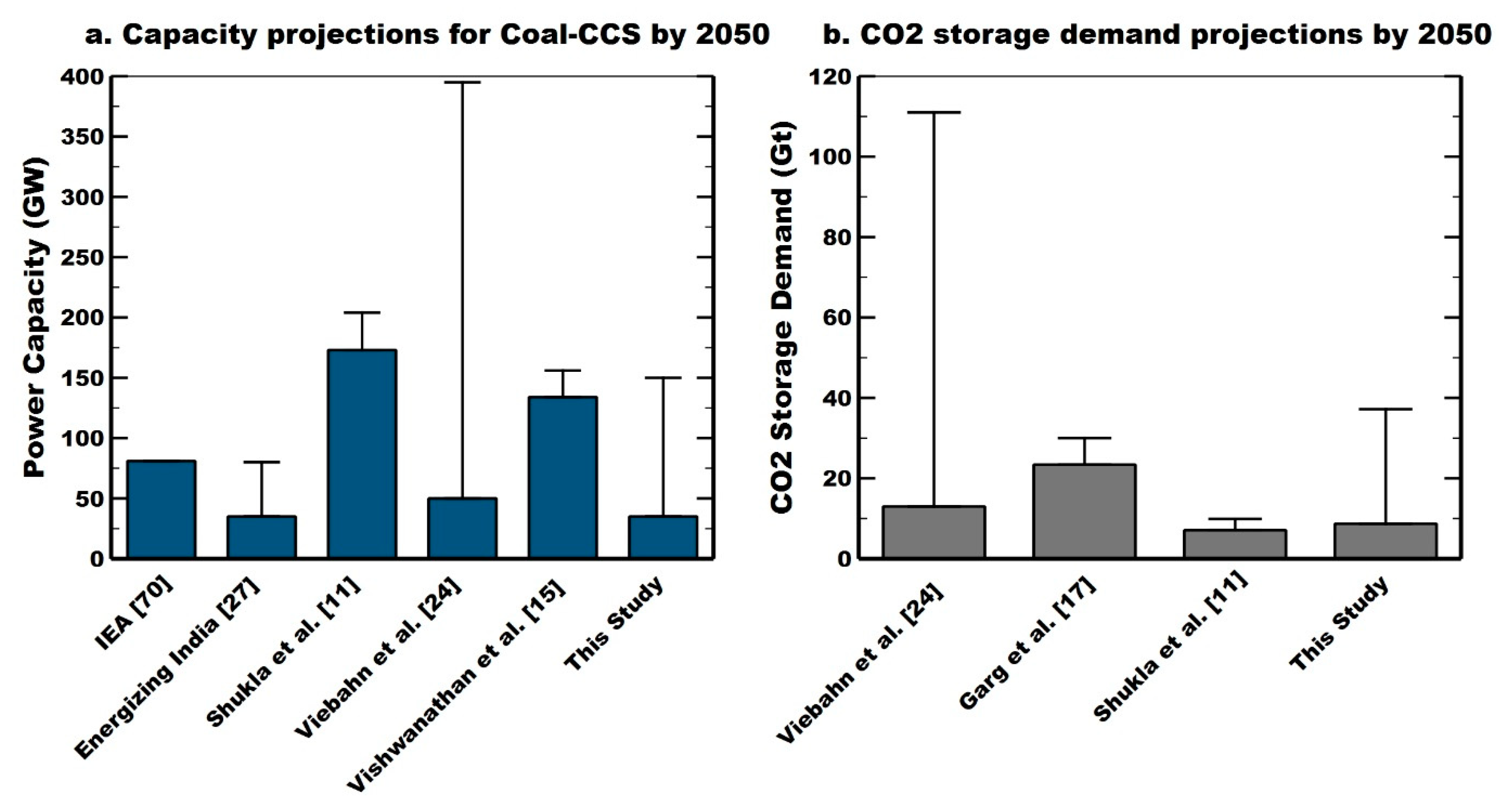
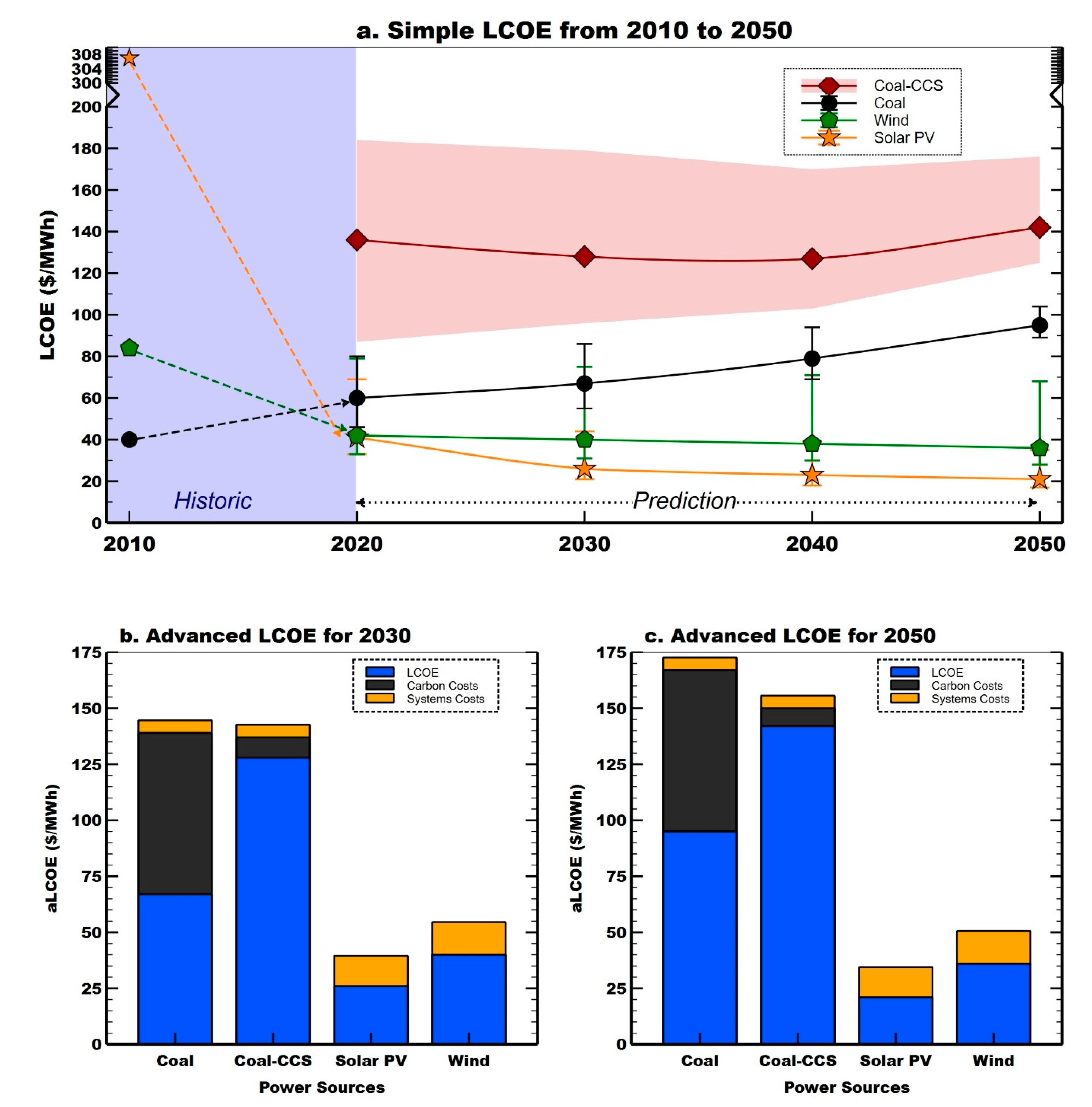
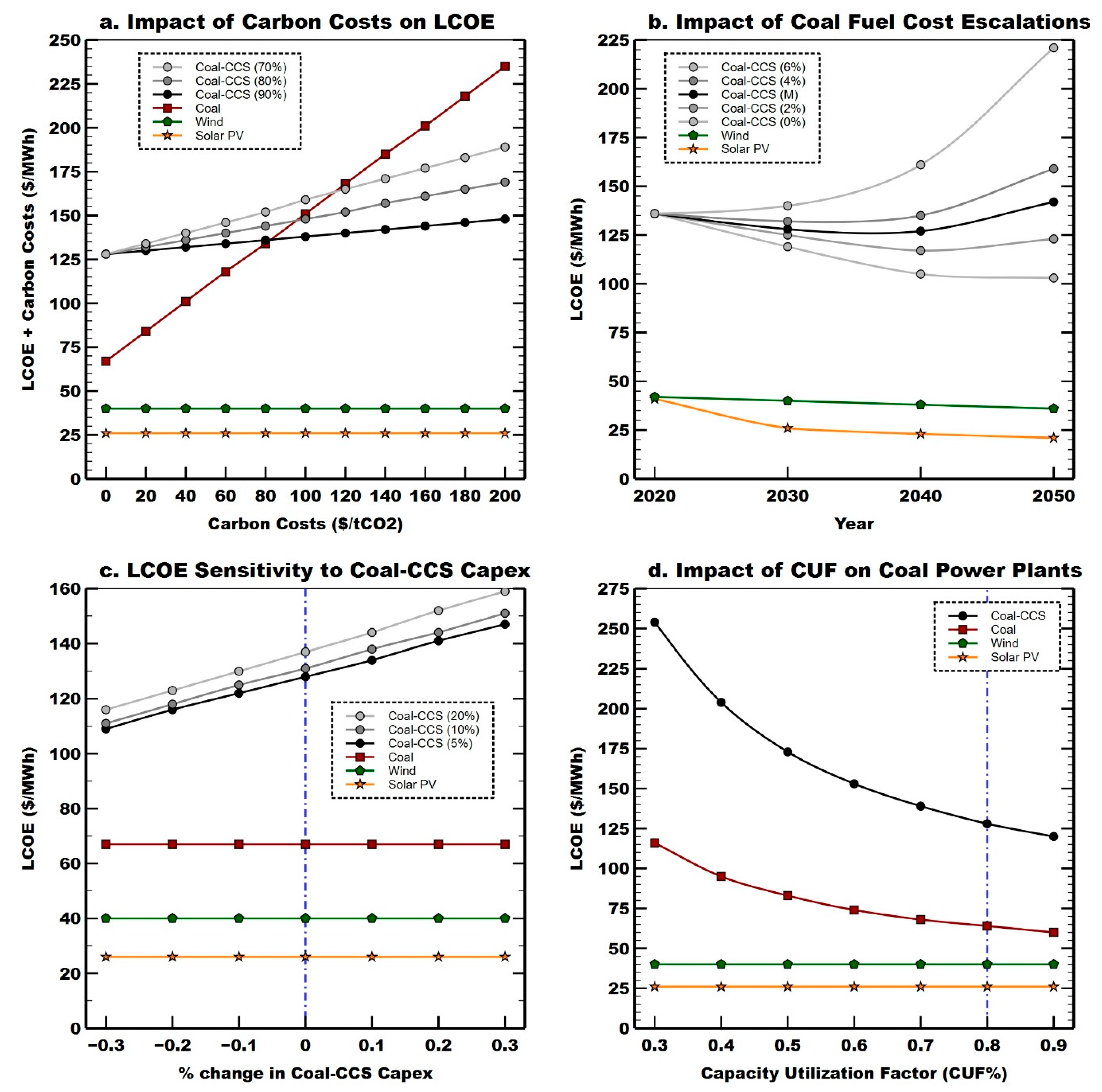
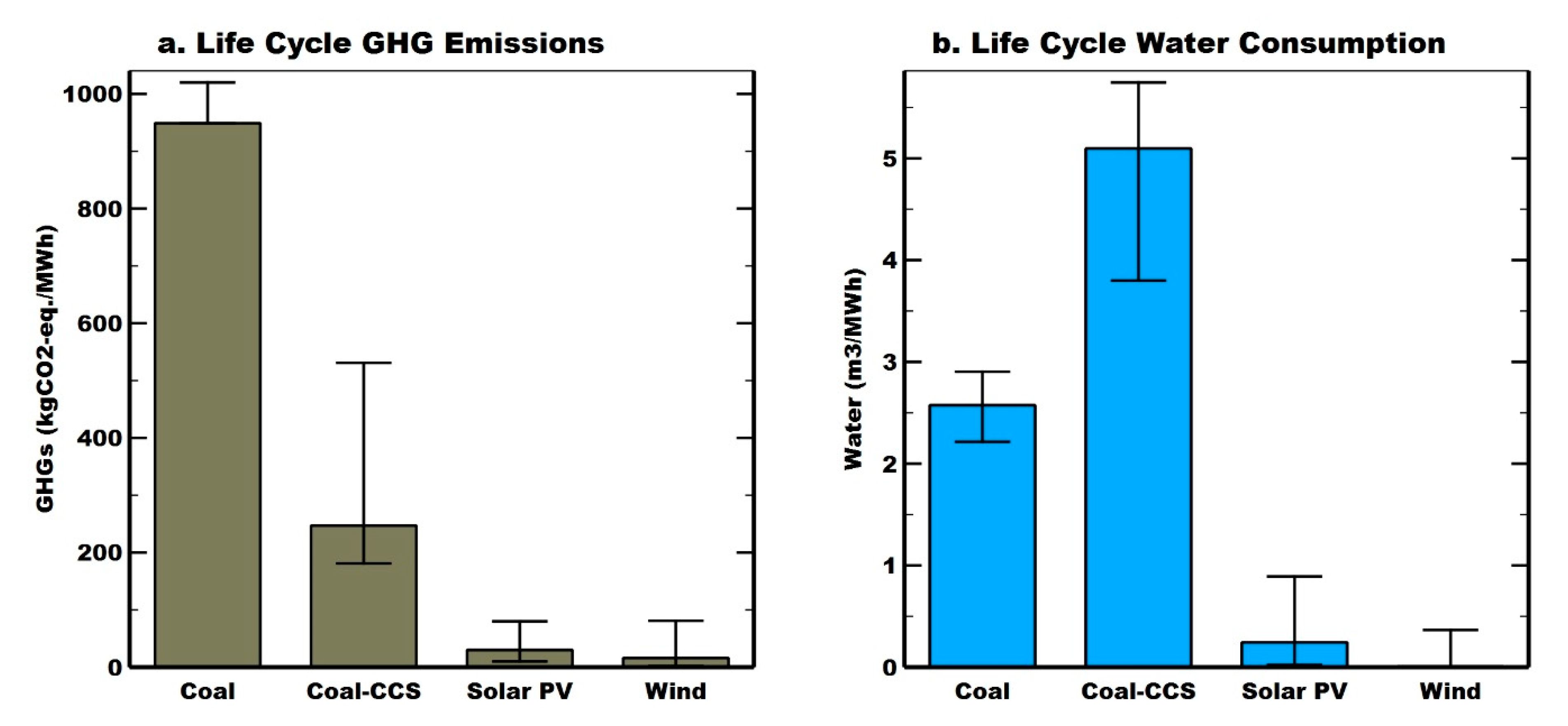
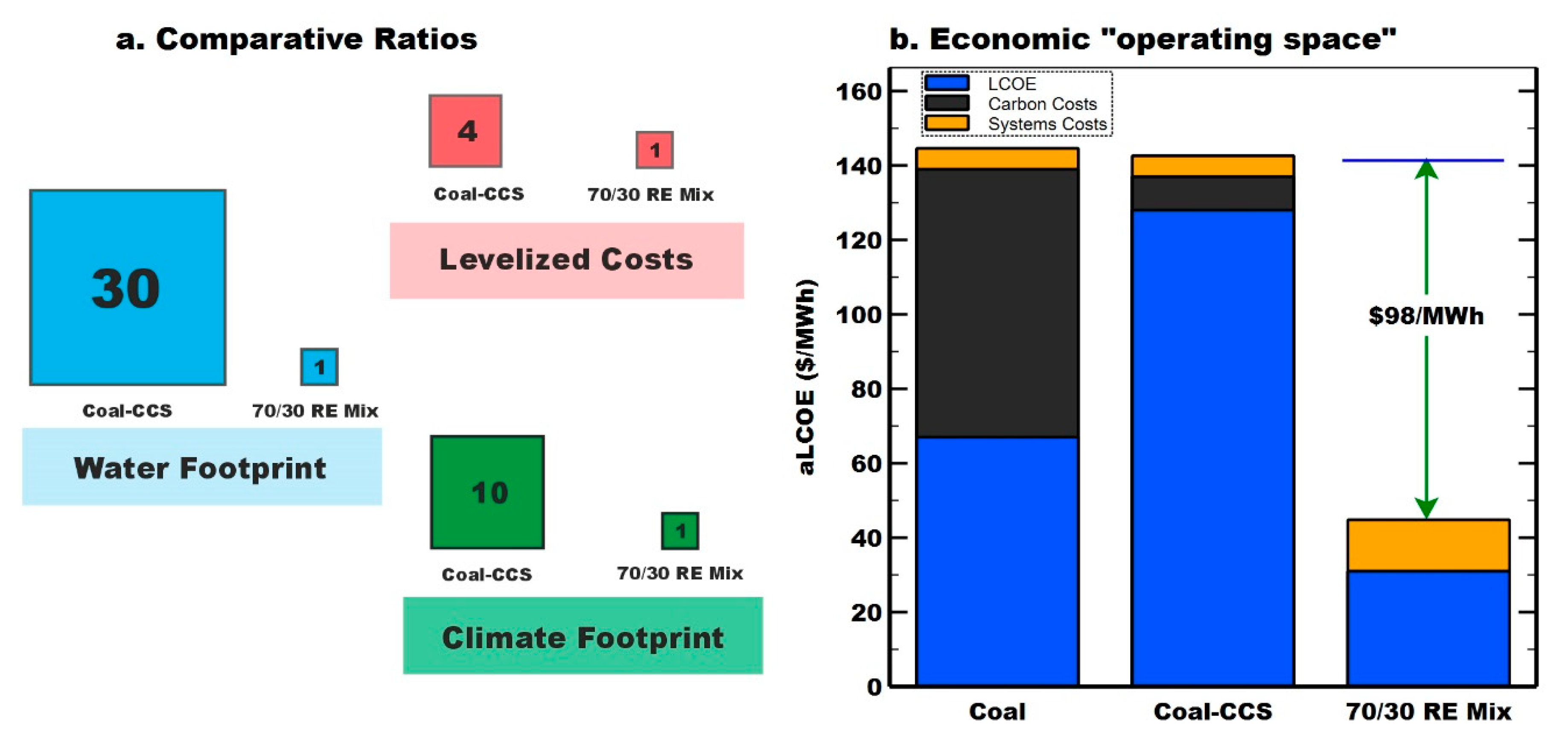
| Study | Year of Commercial Availability | Comments |
|---|---|---|
| IEA [70] | 2030 to 2040 | CCS technology roadmap study. |
| IEA [1,2] | None | CCS will only be feasible in India after being successfully deployed and achieving maturity in industrial countries. |
| Energizing India [27] | Different scenarios: 2017–2027 | Not clear; study lacks clarity and consistency. |
| IESS [28] | Different scenarios: 2017–2032 | Not clear; study lacks clarity and consistency. |
| Vishwanathan et al. [15] | 2 scenarios: After 2020 After 2025 | Not clear; it seems the authors refer to the year of installation of the first CCS projects, not the year of commercial availability. |
| Viebahn et al. [24] | Not before 2030 3 scenarios: 2030/2035/2040 | Considers 2030 as the base case. |
| Singh et al. [25] | No mention | The study assumes CCS deployment scenarios based on [28]. |
| Shukla et al. [11] | After 2030 | Not clear. |
| Greenpeace [29,30] | Not applicable | Suggests coal exit. |
| No. | Indicator | Assessment | Notes—See Text for Explanations |
|---|---|---|---|
| 1 | Future Energy Scenarios | Negative | Coal-CCS capacity projections in India’s future electricity scenarios are very conservative or the technology is ignored altogether. |
| 2 | Carbon Storage Potential | Depends | Systematic quantification and in-depth assessments of potential CO2 storage capacity available across geological reservoirs in the Indian subcontinent are not yet available. |
| Carbon Storage Demand (for Coal-CCS) | Positive | Our cumulative CO2 storage demand estimates for coal-CCS scenarios up to 2050 fall within the good quality storage potential estimate quoted in the literature. | |
| 3 | Commercial Availability | Depends | We think it is still too early to predict the year of commercial availability of large-scale CCS for India’s coal power sector, even though we optimistically assume 2030 as the base year in our assessment. |
| 4 | Levelized Costs (LCOE) | Negative | Coal-CCS is very expensive in comparison to conventional coal and successful renewables; its LCOE is higher by a factor of 3 to 5 in comparison to renewables in 2030. |
| 5 | Advanced Levelized Costs (aLCOE) | Depends | Even though carbon pricing makes coal-CCS competitive in relation to conventional coal power plants, it does not influence the lack of competitiveness of coal-CCS with respect to renewables. |
| 6 | Climate Footprint | Depends | Coal-CCS might eventually act as a technology intervention to decarbonise the power sector if India follows a coal-dominant future pathway; however, its life cycle GHG emissions will still be higher by a factor of 8 to 15 in comparison to renewables. |
| 7 | Water Footprint | Negative | Coal-CCS has nearly twice the water footprint of conventional coal plants and consumes enormous amounts of water in comparison to renewables (20 to 900 times more). |
Publisher’s Note: MDPI stays neutral with regard to jurisdictional claims in published maps and institutional affiliations. |
© 2021 by the authors. Licensee MDPI, Basel, Switzerland. This article is an open access article distributed under the terms and conditions of the Creative Commons Attribution (CC BY) license (http://creativecommons.org/licenses/by/4.0/).
Share and Cite
Hiremath, M.; Viebahn, P.; Samadi, S. An Integrated Comparative Assessment of Coal-Based Carbon Capture and Storage (CCS) Vis-à-Vis Renewable Energies in India’s Low Carbon Electricity Transition Scenarios. Energies 2021, 14, 262. https://doi.org/10.3390/en14020262
Hiremath M, Viebahn P, Samadi S. An Integrated Comparative Assessment of Coal-Based Carbon Capture and Storage (CCS) Vis-à-Vis Renewable Energies in India’s Low Carbon Electricity Transition Scenarios. Energies. 2021; 14(2):262. https://doi.org/10.3390/en14020262
Chicago/Turabian StyleHiremath, Mitavachan, Peter Viebahn, and Sascha Samadi. 2021. "An Integrated Comparative Assessment of Coal-Based Carbon Capture and Storage (CCS) Vis-à-Vis Renewable Energies in India’s Low Carbon Electricity Transition Scenarios" Energies 14, no. 2: 262. https://doi.org/10.3390/en14020262
APA StyleHiremath, M., Viebahn, P., & Samadi, S. (2021). An Integrated Comparative Assessment of Coal-Based Carbon Capture and Storage (CCS) Vis-à-Vis Renewable Energies in India’s Low Carbon Electricity Transition Scenarios. Energies, 14(2), 262. https://doi.org/10.3390/en14020262







